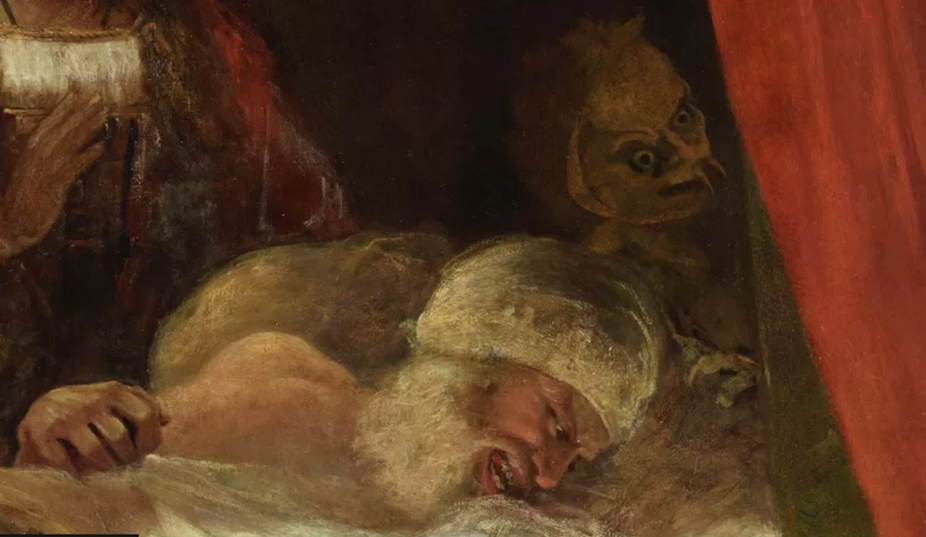Recent news that restorers had uncovered the image of a Gothic-looking demon in a late work by Sir Joshua Reynolds (1723-1792) seems fitting for these long, dark evenings. The sinister face hovers above the head of a dying clergyman in The Death of Cardinal Beaufort, painted in 1789.
Fake-or-Fortune-style reveals such as this, where Reynolds’s hollow-eyed fiend re-emerges, fanged and uncanny from the gloom of centuries of overpainting, are always popular with the public. But what are we to make of Reynolds’s devilish detail in his painting, and how does it fit into the larger story of demonic representation in the art and literature of the 18th century?
First of all, we can be sure that the painted demon was put there by Reynolds because it was much discussed at the time. The scene of the dying cardinal comes from Shakespeare’s Henry VI Part II. Witnessing bedside the death throes of Beaufort – a corrupt, mad and guilt-ridden figure – King Henry beseeches God to drive away “the busy meddling fiend / That lays strong siege unto this wretch’s soul”.

In Shakespeare’s writing, this fiend is a figure of speech, a metaphor for mental torment. Unconventionally for a painter at the time, Reynolds gives a face to this devil, and makes the fiend a visible being. It leers out of the shadows, behind Beaufort’s pillow, a grotesque detail out of character in Reynolds’s usual art of grand portraiture and soberly historical picture subjects.
Reynolds’s contemporaries were deeply critical of the inclusion of this demonic creature in an otherwise traditional history painting. Doubtless this had to do with Reynolds’s official status as the president of the Royal Academy of Arts (which champions art and artists) and author of 15 lectures on art, known as the Discourses. The art theory of the day, as far as history painting was concerned, favoured improving subjects, rendered in an idealised manner, but taken from the life. There was little room for the fantastical or the macabre, for several reasons.
Demons in the Age of Reason
Broadly speaking, the Age of Reason saw “the death of Satan”, when science and rational thought sought to replace the religious superstitions of the previous century. Devils and demons, since they couldn’t be proven to exist in this new era of factual enquiry, lost much of their fear-driven religious power as tangible beings at loose in the world, sent to punish sinners.

Yet demons didn’t altogether disappear. In literature, they left the realm of physical possibility and entered the mind as metaphors for the human struggle between good and evil. As such, demons retained their moral function of teaching good souls how not to behave. Now the punishment for sin was not eternal damnation but the threat of a far more real internal mental conflict, madness and even suicide.
In the new genre of the novel, especially, writers could still explore the dark forces working beneath the surface of the human condition through devilish allusions while reassuring readers that good moral conduct was within their own control. In Daniel Defoe’s Robinson Crusoe (1719), Moll Flanders (1722) and Roxanna (1724), or Samuel Richardson’s Clarissa (1748), demons don’t appear as such, but the behaviour of key characters is repeatedly described in devilish language.
The most frightening concepts, it was thought, were best left as suggestions of the mind. Embodied devils and demons only appeared on stage or in the Gothic novel later in the 18th century. In the latter they were often found in disguise, as in MG Lewis’s Ambrosio the Monk (1796).
In art, the shift towards the Gothic was influenced by Henry Fuseli (1741-1825). His painting The Nightmare showed a real-looking demon, larger than life, crouching on the body of a sleeping woman. The imp caused a sensation when the painting was shown at the Royal Academy in 1782.

Fuseli earned the nickname “Painter in Ordinary to the Devil”, and was influential in London for his visionary images in this newly fashionable style. One such fan was Sir Joshua Reynolds, who became closely acquainted with Fuseli and an admirer of his work.
In 1789, they both contributed paintings to John Boydell’s Shakespeare Gallery, a commercial exhibition space on Pall Mall which commissioned the best artists of the day to make pictures of subjects taken from Shakespeare.
This was the context for Reynolds’s fiend in The Death of Cardinal Beaufort, which appeared in that exhibition. Tellingly, Fuseli had already shown a drawing of the same subject at the Royal Academy as early as 1772, a work in which Beaufort’s own face took on a demonic look with reference to his internal possession.
By the 1780s, Shakespearean fiends were common among Boydell’s artists. George Romney (1734-1802) made several sketches of other scenes in Henry VI Parts I and II where demons are conjured up by characters, and a painting of Joan of Arc doing the same, now lost.
Demons and devils visibly re-entered the art of the 18th century in the realm of satire. Here, in the monochrome print, winged or inky black devils became symbols for a host of contemporary social problems. Hogarth spoofed the religious convictions of the Methodist Church by having a little devil whisper in the ear of a sleeping congregant.
Satirist James Gillray pilloried the scourge of the 18th-century gluttonous diet, the painful condition of gout, depicting it as a sharp-toothed demon, sinking its fangs into a well-fed human foot.
Thus in 1789, the year of the French Revolution, far from losing the plot, the ageing Reynolds was part of a revolution in art that saw the demons of the imagination, so beloved of 18th-century literature, brought back vividly into the visual realm.

